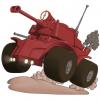I recently started playing around with the tool Marvelous Designer... for anyone that does not know the tool (and is to lazy to follow the link... no, I am not paid by anyone to make shameless ads, the link is just there as explanation for the uninitiated ![]() )
)
I have to say I am highly impressed and skeptical at the same time. The cloth physics engine is impressive, and for simple clothing you get good results quickly.
I am a little dissappointed about the performance of the tool though, first I thought that it was strange that all the vids I have seen of somebody presenting their virtual clothing with an animation from MD had hacky animations with low FPS... surely not all of these people could be using a toaster for a PC?
Then I tried it on my own Workstation, which might have Gamer Hardware that is now ageing being 3 years old, but was top of the crop 3 years back and is still very strong today: a 6 core i7 with hyperthreading, a GTX 580 and 24G of RAM should give MD enough power for all its cloth physics black magic.
Yet even with my PC, things get really slow as soon as I start to reduce the Particle Distance, which seems to be MD language for Mesh Resolution.
Then there is the whole thing with the cloth pattern creation. To say the whole thing is giving me headaches is an understatement. I have no idea about cloth sewing in RL, so while creating a basic skirt or shirt might be easy in MD, as soon as it gets more complicated, I start to struggle.
while I really like the idea of not having to sculpt all the folds in my clothing items by hand, getting down the basic shape of the clothing and then adding the details seems to be really painful with the limited toolset MD currently is equipped with.
So my question to anyone that has already tried the tool, or might even be a pro user: What is your opinion on it? Is it worth its asking price, does it REALLY help with efficiently sculpting clothing items for game characters, or is it in the end just saving time on one end while adding headaches at another?
Also, as a total newbie, I am struggling with some things:
1) the only symmetry I found was "copy as symmetrical", which means you will have a seam in the middle. Woot? It just can't be that there is no symmetry tool available for creating clothing pattern patches in a symmetrical fashion without a seam in the middle. Did I miss something?
2) Is there a function to import a Pattern, or at least a image file as a rough pattern guide to draw over? I am thinking about creating the basic shapes in 3D Coat, unwrapping them and then using the UV set as cloth pattern in MD. I am much more proficient with Voxmodelling than with creating clothing patterns.
3) Did anyone found the reason for the bad performance of MD? Is it just missing any kind of Multithreading or GPGPU Acceleration (which I suspect it is)... is there an option I missed that leads to the bad performance on my machine?
I am aware that I might need to take my questions to the MD Forum for a better response, I just wanted to see if there some users here have made any expierience with the tool... usually you will not find the highly critical users on the message board of the company creating a software itself. And there seems to be a big hype around MD which I struggle to fully understand, so to speak.









